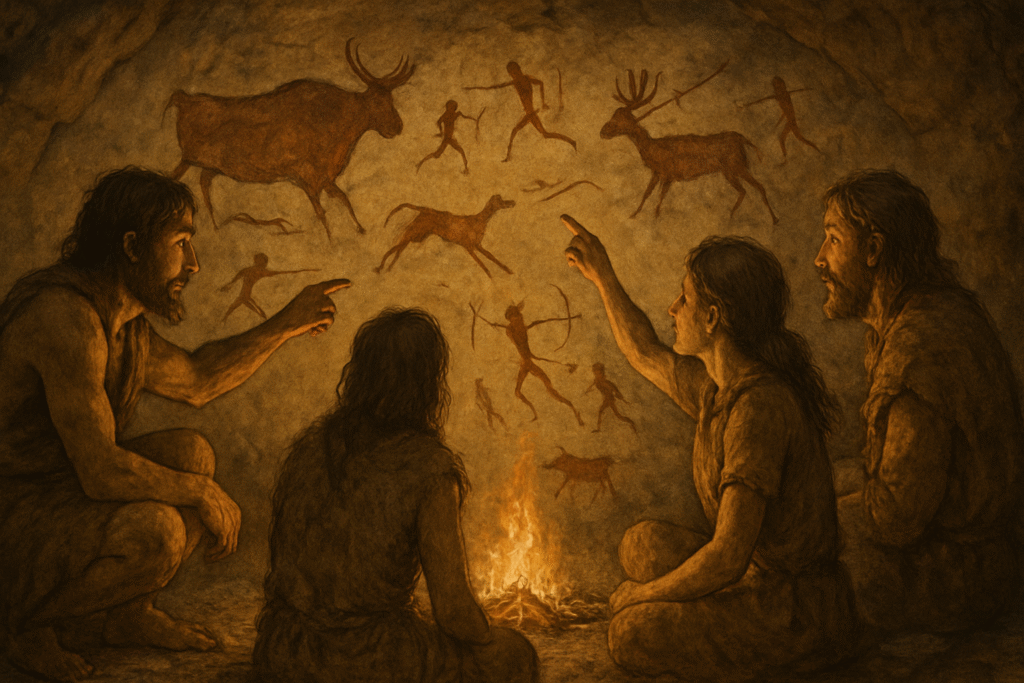Storytelling is the simple act of sharing a tale—whether by speaking, writing, singing, or performing. It’s how people pass on ideas, feelings, history, and values. Stories often have characters, a setting, a problem, a build-up, and a resolution. It can be as big as a legend or as small as “what happened on my way to work.” Storytelling connects us, teaches us, and helps us understand the world around us. It’s common to all cultures, even the oldest ones.
Read more : What Is Marketing & Why It Matters? 2026
Why Did Storytelling Begin?
The Earliest Beginnings
- People began telling stories long before writing existed. Oral stories were shared around fires, in gatherings, and in rituals. Wikipediatalkingstories.uoregon.edu
- The earliest known stories go back tens of thousands of years—ancient cave paintings in Europe (around 30,000 years ago) and Australia (up to 40,000 years ago) likely told stories or helped people remember them. janemucklow.mvsite.appA Quintillion Words | Book Reviewer

Early Written Stories
- Writing brought stories into new forms. The Epic of Gilgamesh (around 700 B.C.) and Homer’s Iliad are among the oldest known written stories. This also includes Aesop’s Fables from the same era. Words AliveWikipedia
- Storytelling was also used in ancient civilizations like Egypt, Greece, India, and Mesopotamia to preserve beliefs, morals, and cultural memory. Freewrite StoreWikipedia+1
Summary
People began storytelling as a way to share knowledge, entertain, teach lessons, and connect communities—first orally, then in written form as soon as writing existed. It has been around for tens of thousands of years and continues to evolve across every culture. A Quintillion Words | Book Reviewertalkingstories.uoregon.eduDean Francis Press
Why Is Storytelling So Powerful?
- Emotion Beats Logic
Our brains are wired for stories. When we hear a story, many parts of the brain activate—not just the language center, but also the parts that feel emotions and imagine experiences. That’s why stories are easier to remember than raw facts. WikipediaUpward Spiral GroupThe New Yorker - Stories Build Trust and Empathy
A well-told story builds an emotional bridge between the teller (or brand) and the listener. That bond builds trust—people feel seen, understood, and connected. Oxford AcademicForbesMarketing Insider Group - Stories Make Messages Memorable
Super Bowl ads with a full narrative structure tend to be more memorable—even more than humor or cute visuals. One marketing expert said: “Whole movies, really, crunched into thirty seconds.” The New Yorker - Stories Move People to Act
Emotionally charged stories can trigger chemicals like oxytocin—the “bonding” hormone—which increases empathy and even leads people to donate or take action. The New Yorker - Stories Shape Identity and Culture
In many ancient communities—like West African cultures—storytellers (griots) carried voices of ancestors, histories, and social values forward. They weren’t just entertainers; they were keepers of wisdom. Wikipedia

Read more : Why is Social Media Marketing Important?
Why Is Storytelling Important?
- Culture & Education: Stories teach traditions, history, values, and social rules—especially in communities without written history. Wikipedia+1talkingstories.uoregon.edu
- Therapy & Healing: Sharing one’s story can help heal—it allows people to face and process emotions, create identity, and share experiences. Storytelling is used in therapies and group healing. Wikipedia
- Business & Leadership: Leaders use stories to inspire teams, shape company culture, and present ideas in a way that motivates action. InvestorsThe Times
- Marketing & Branding: Brands use stories to stand out, connect emotionally, and make their message resonate with customers. Oxford AcademicUpward Spiral GroupMailchimpForbes
Why Is Storytelling Critical in Marketing?
In marketing, storytelling becomes immensely important because:
- Emotional Connection
Brands that tell human stories—about real challenges or real people—create empathy and affinity. For instance, Dove’s “Real Beauty” campaign used real women to challenge beauty norms, forging emotional connections and strong brand loyalty. Upward Spiral Group - Engagement and Loyalty
Story-driven campaigns hold attention longer, encourage shares, and foster loyalty. Customers don’t just buy a product—they join a story. ForbesSarah KlongerboMarketing Insider Group - Differentiation in Crowded Markets
When many brands sell similar products, unique stories become competitive advantage. Storytelling humanizes the brand and makes it easier to stand out. ForbesVogue Business
As one recent trend points out, luxury brands are embracing this by turning themselves into entertainment studios, producing cinematic storytelling that immerses audiences in brand worlds rather than just pushing products. Vogue Business - Brands as Story Platforms
Modern campaigns—like Saint Laurent’s film studio or Miu Miu’s short-film series—show how brands can build entire universes around their values and aesthetics, inviting fans into immersive narratives. Vogue Business

Read more : What Is Marketing Automation?
What Are Some Effective Storytelling Techniques?
Here are some commonly used techniques that make storytelling effective:
1. Structure: Beginning, Middle, End
Keep it simple and structured:
- Beginning: Introduce characters or conflict
- Middle: Build tension
- Ending: Resolve, deliver insight or emotion
Leaders use this structure to craft powerful business pitches that stick. InvestorsThe Times
2. Focus on the Audience’s Feelings
Tell stories that reflect the listener’s challenges or values. That creates empathy and makes them the “hero” of the story. The Times
3. Use Real Examples
Dove’s “Real Beauty” campaign used real women’s stories—relatable and authentic, forging stronger bonds. Upward Spiral Group
4. Tap Our Brains
Engage the brain by describing sensory details, emotions, or vivid scenes—it activates memory and emotion. WikipediaThe New Yorker
5. Leverage Myth or Archetypes
Ancient oral traditions use repeated formulas, archetypes, and familiar structures to help audiences follow and remember. Wikipedia
6. Multimedia / Transmedia
Tell a story across different media—video, print, social, interactive. Coca-Cola’s “Happiness Factory” campaign is a classic example. Wikipedia
7. Simplicity & Emotion
Use easy language, short sentences, and emotional truths. Steve Jobs’ iPhone launch speech is a perfect example—no hard sell, just excitement about “what it will help you achieve.” The Times
8. Make It Relatable
Use analogies, everyday words, and personal anecdotes. “We’re the AAA for home emergencies”—a simple analogy that made a business understandable. The Times
When Did Storytelling Begin?
- Prehistoric Era: Humans told stories through art and oral traditions as far back as 30,000–40,000 years ago. janemucklow.mvsite.appA Quintillion Words | Book Reviewer
- Ancient Civilizations: Written stories appeared with cuneiform (~3100 B.C.), Epic of Gilgamesh (~2000–1000 B.C.), Iliad (~700 B.C.), Aesop’s Fables. Words AliveA Quintillion Words | Book ReviewerWikipedia
- Across Cultures: Storytelling remained vital in cultures worldwide—oral traditions, griots, religious narrators, myths, legends, even now in digital formats. Wikipedia+1

Read more : What is Lead generation and how does it works?
Summary of Key Points
| Topic | Highlights |
| What is storytelling? | Sharing stories verbally or visually to teach, entertain, or connect. |
| Earliest origins | Prehistoric art and oral traditions, evolving with writing in ancient civilizations. |
| Why it’s powerful | Engages emotion, activates memory, builds empathy and action. |
| Importance overall | Preserves culture, aids education, heals, inspires, builds community. |
| Marketing importance | Helps brands connect, stand out, engage deeply, and build lasting loyalty. |
| Techniques | Simple structure, emotional focus, real examples, relatable analogies, multimedia, and clarity. |
| When it began | Thousands of years ago—a human constant since the dawn of culture. |
Conclusion
Storytelling is not just an art—it’s the heart of human communication, culture, and connection. From ancient cave paintings to modern brand films, stories have formed our history and shaped our emotions. In marketing, storytelling is especially important. Brands that tell real, emotionally resonant stories rise above noise, build trust, and inspire action.
For readers: whether you want to connect with others, lead a team, or sell a product, storytelling is your most powerful tool. Start with a simple structure, speak from the heart, and weave in authenticity. Your story can change minds—and even shape the future.
Final Thoughts & Call to Action
I hope this clear guide helps you understand what storytelling is, why it’s so powerful, and how you can use it—especially in marketing. Want help crafting your own brand story or using storytelling in a blog, presentation, or campaign? I’d be happy to assist you—just ask!
Read more : What Is Target Audience?
FAQs About Storytelling
1. What is storytelling in simple words?
Storytelling is the act of sharing a story—through words, visuals, or actions—to teach, entertain, or connect with others.
2. Why is storytelling so powerful?
It’s powerful because it connects with human emotions, makes messages memorable, and inspires action more effectively than plain facts.
3. Why is storytelling important in marketing?
Storytelling helps brands build trust, connect emotionally with customers, and stand out in a crowded market.
4. What are common storytelling techniques?
Some common techniques include: using a clear beginning-middle-end structure, focusing on emotions, sharing real examples, and keeping it simple and relatable.
5. When did storytelling begin?
Storytelling began tens of thousands of years ago, starting with oral traditions and cave paintings, long before written language.
6. Can storytelling improve business communication?
Yes. Leaders and marketers use storytelling to make complex ideas simple, motivate teams, and inspire customer loyalty.
We are a Digital Marketing Agency , From SEO to performance marketing, we deliver results that boost visibility, leads, and ROI.

